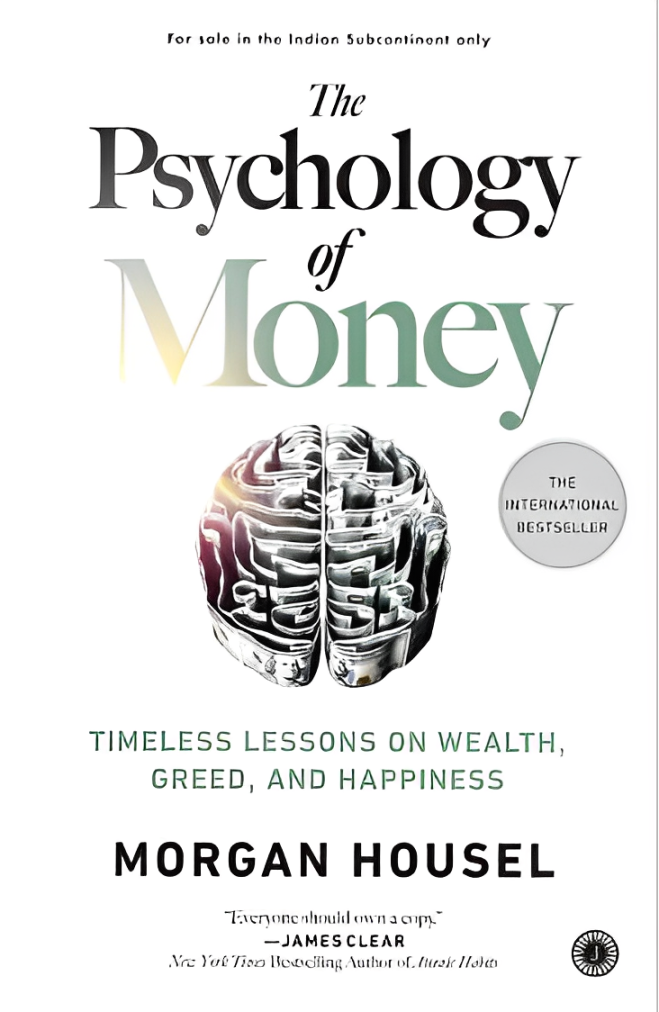
MYRA
There have been many excellent books on the nature of money, finance and markets written in an accessible manner. A recent one on the bookshelves is “The Psychology of Money” by author Morgan Housel. Housel’s book has garnered a lot of popularity among readers of all stripes. For a start, the author steers clear of oft cited cliches in personal finance books including: get-rich-quick ideas, and the one- size-fits-all plan. Its popularity is not terribly surprising considering the book contains lots of good examples, fun facts and presents arguments well-founded in data, all of which makes it an easy and enjoyable read. This book argues that a person’s financial priorities must spring from the quality of life they are pursuing and that the two cannot be separated. Furthermore, the author’s desire to blend the behavioral science with financial outcomes is quite apparent throughout the book. He makes it clear that people’s financial decisions are rarely driven by math and logic and that most financial inflections can be traced back to endorphins and cortisol levels. In short, Housel states that a person’s financial wellbeing has little to do with how smart they are and a lot more to do with how they behave.
Like most other authors in this area, Housel starts by reiterating the connection between one’s physical and mental wellbeing with their ability to be (and remain) financially independent. However, the crux of contents in this book talks not just about how one can take steps to accumulate wealth, but also addresses how to condition one’s mind to stay wealthy. The author illuminates the fact that, when it comes to money, it is just as important for an investor to condition their psyche as it is to take a structured approach to building financial wealth. The lessons from this book can be summarized in seven ‘to-do’ capsules, and three ‘don’t-do’ capsules.
For MBA students, this book is a great introduction to the complex world of investor behavior and market dynamics. Housel artfully weaves together practical insights and timeless wisdom, offering readers a roadmap to achieve financial gains. Let’s delve into the key lessons presented by the author.
Seven important things to do:
1) Lesson 1: Save Money– Housel’s first lesson emphasizes the importance of cultivating a consistent savings habit. He advocates for the power of small, regular contributions, highlighting the compounding effect that can significantly impact one’s financial trajectory over time. By instilling discipline in saving, readers can harness the long-term benefits of compounding and build a robust financial foundation. In his book Housel quotes plenty of examples and studies which show that people often underestimate or overlook the power of savings, and clears up misconceptions using data.
2) Lesson 2: Wait for the Compounding Effect– Unlike other authors in this field, Housel takes an unusual example weaving ideas from geology, climate change and nineteenth century meteorological theories to describe why humans have a hard time appreciating the power of compounding. The second lesson echoes the timeless principle of patience. Housel encourages readers to embrace the compounding effect, emphasizing that the true magic lies in giving investments the time they need to grow. This lesson serves as a reminder to resist the allure of quick wins and stay focused on the long-term journey. To illustrate this idea in a nutshell: let us say that you want to invest 1 lakh rupees today at 15.5% per annum with a goal of earning 15X (fifteen lakhs) in the next twenty years. In such a setup you will accumulate almost 67% of your desired gain after the 13th year.
3) Lesson 3: Stick to Your Investment Strategy– Lesson three stresses the importance of aligning investment strategies with individual risk tolerance and financial goals. Housel argues that consistency in approach, combined with a deep understanding of personal risk appetite, is crucial for weathering market fluctuations and achieving sustainable returns. He also cautions investors against taking financial cues from people playing a different game and highlights the importance of tailoring investments to meet an individual’s needs.
4) Lesson 4: Understand that Luck and Risk are Inseparable– Housel’s fourth lesson introduces the unpredictable nature of luck in financial outcomes. He cautions against investors looking to mindlessly imitate a famous, successful investor in the hope achieving overnight success. The author notes that the idea of studying only specific or highly-successful examples will lead to the study of extremes; only billionaires and CEOs. Housel educates the reader about why studying such examples where the path dependency (in short, “luck”) played a decisive role is almost useless for informing one’s investment strategy. He, instead, encourages investors to study broad patterns for success rather than individual star performers. Housel quotes the example of Russell 3000 Index, which since 1980 has yielded over 73-X the original amount -a spectacular return by any measure. However about 40% of the companies in the basket have failed over time, while 7% have shown stellar performance which offset the losses. Using this and other examples, the author urges investors to approach the market with a ‘batting average’ mindset. By acknowledging the role of both good and bad luck, investors can develop a more nuanced perspective on success and failure, fostering resilience in the face of uncertainty.
5) Lesson 5: All Should Pay the Price– in many ways this is an extension of the previous lesson on risk. Housel’s note to investors is crystal clear: seeking higher returns will exact a higher price, and vice versa. While the relationship between risk and return is intuitive to most market participants, Housel notes that every admission has a price and but not all prices appear on labels. He illustrates, using different scenarios and examples, how novice investors spend lot a of effort on timing entry/exit strategies to skirt the price of admission while playing the market, i.e. scoop the highs while avoiding the dips. In other words, these players want to enjoy all the gains while avoiding the penalties of downward movements. Housel notes that it is impossible to consistently decouple risk (which he calls ‘the price’) from the returns. The author hits home this point with a discussion on how GE’s investors paid (and still are paying) the price of Jack Welch’s style of management ever since the Sub-Prime crisis of 2007-08. Housel’s lesson for investors is that there are no risk-free returns from the market.
6) Lesson 6: Make Room for Error– in this lesson the author takes a philosophical, but empirically grounded view of the fact that life rarely goes according to plan. Especially a long-term plan. In particular the author weighs in on investors falling into psychological traps during good times and bad. For instance, investors trading on strong recency bias or falling prey to anchoring effect. The author outlines, using the example of gamblers in casinos, how investor psyche baits them into making bad trades. Housel makes a strong case for why investors need to stay humble and make room for uncertainty, bias and randomness which are ever-present and inextricable from life. He notes that the best investors build a margin of safety to factor-in this error.
7) Lesson 7: You Will Change, So Will Your Needs– this is another section where the author talks first about living well, before talking about financial advice. The message here is straightforward -as the decades pass, a person will change, and so will their needs. In that long journey avoid making extreme choices with heavy sunk costs – costs which become a crushing burden over time. To make this point Housel illustrates two extreme cases, one that of a part-time worker who finds himself nothing to retire on at age 65, and of another employee whose only goal was to chase dollar until he irretrievably damaged his health at age 45; in this example both actors have accumulated heavy costs, one financially and the other in terms of health. The author uses many such examples from the real world to persuade the reader to think long term, while staying on a flexible path to a fulfilling life.
Three Important Mistakes to Avoid:
1) Mistake 1: Stroking Your Ego by Spending– Housel encapsulates this idea in the following sentence, “when you define savings as the gap between your ego and your income you realize why many people with decent incomes save so little”. The author, while emphasizing the need to save money, also recounts a variety of cases where too many people earning decent incomes tend to spend on brands, indulgences and behaviors to stroke their ego. Housel notes that showing off your possessions almost never attracts the right kind of people you would want to have in your life; and that the people who are impressed by your possessions are seldom your well-wishers. He shows how people engaging in financially destructive behavior feel worse in the long term and have a much harder time rebuilding their wealth.
2) Mistake 2: Being Overly Greedy– in this warning, the author takes a rather conservative approach in conveying that “greed is good” is an ill-thought idea. Housel notes that too much greed will push an investor to the point of regret. The author elucidates this idea using examples from the real world on how people will not risk certain things in life no matter how big the gain, while they behave irrationally with their investments. The author encourages investors to take consistent, sizeable returns without taking on excessive risk driven by greed.
3) Mistake 3: Taking a Pessimistic View of Investing– this is perhaps the author’s most important lesson for all the conservatively minded investors out there. In this lesson the author sheds light on how a person’s worldview will make them look at investing. He highlights the fact that most conservative or risk averse actors tend to overweight negative outcomes in the market and steer clear of long-term market risks. This is an unhealthy approach to financial planning. In fact, as Housel notes, on balance of things it is the prudent, patient investor who has gained the most over time.
In summary, Morgan Housel’s “The Psychology of Money” offers an illuminating discussion on financial wisdom, acting as a comprehensive guide to navigating the intricacies of life, individual mindset and investments. By blending practical advice with psychological insights, Housel equips readers with the tools to make informed decisions and build a resilient financial outlook. This book is a solid choice for anyone seeking to learn more about the psychology behind successful personal financial management.
Written by
Prof. Abhijith Seetharam
Assistant Professor – Analytics & Data Science

